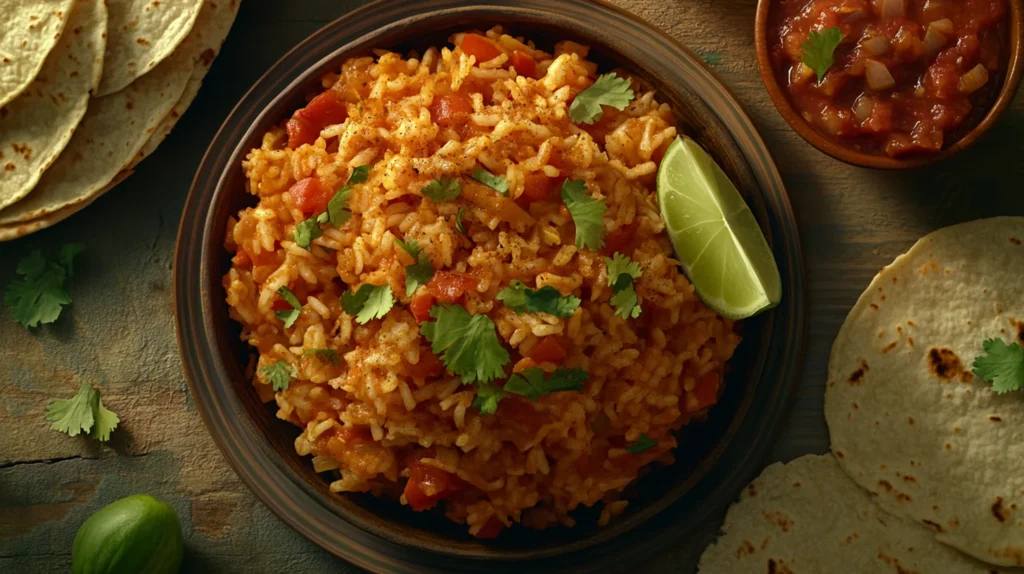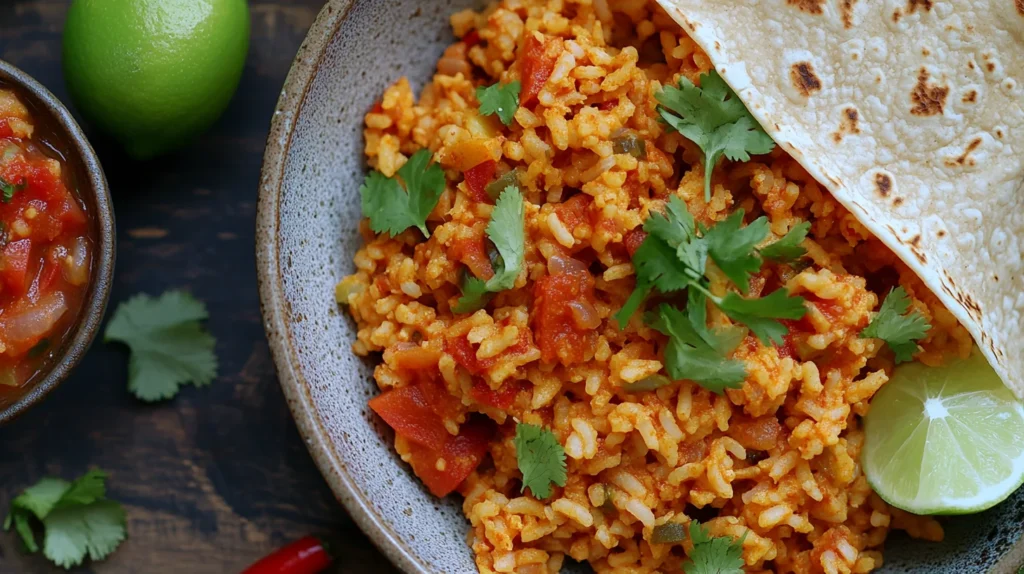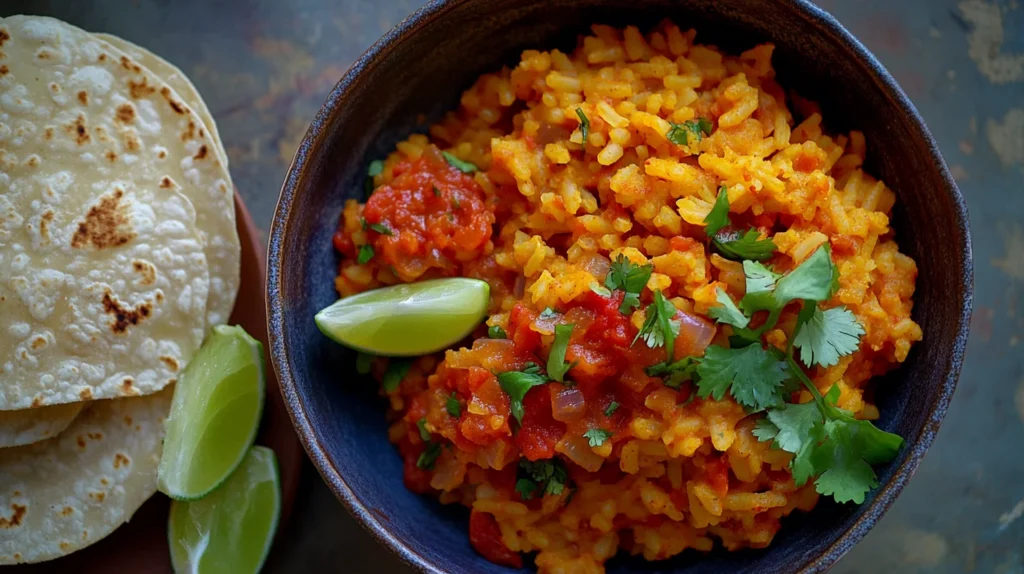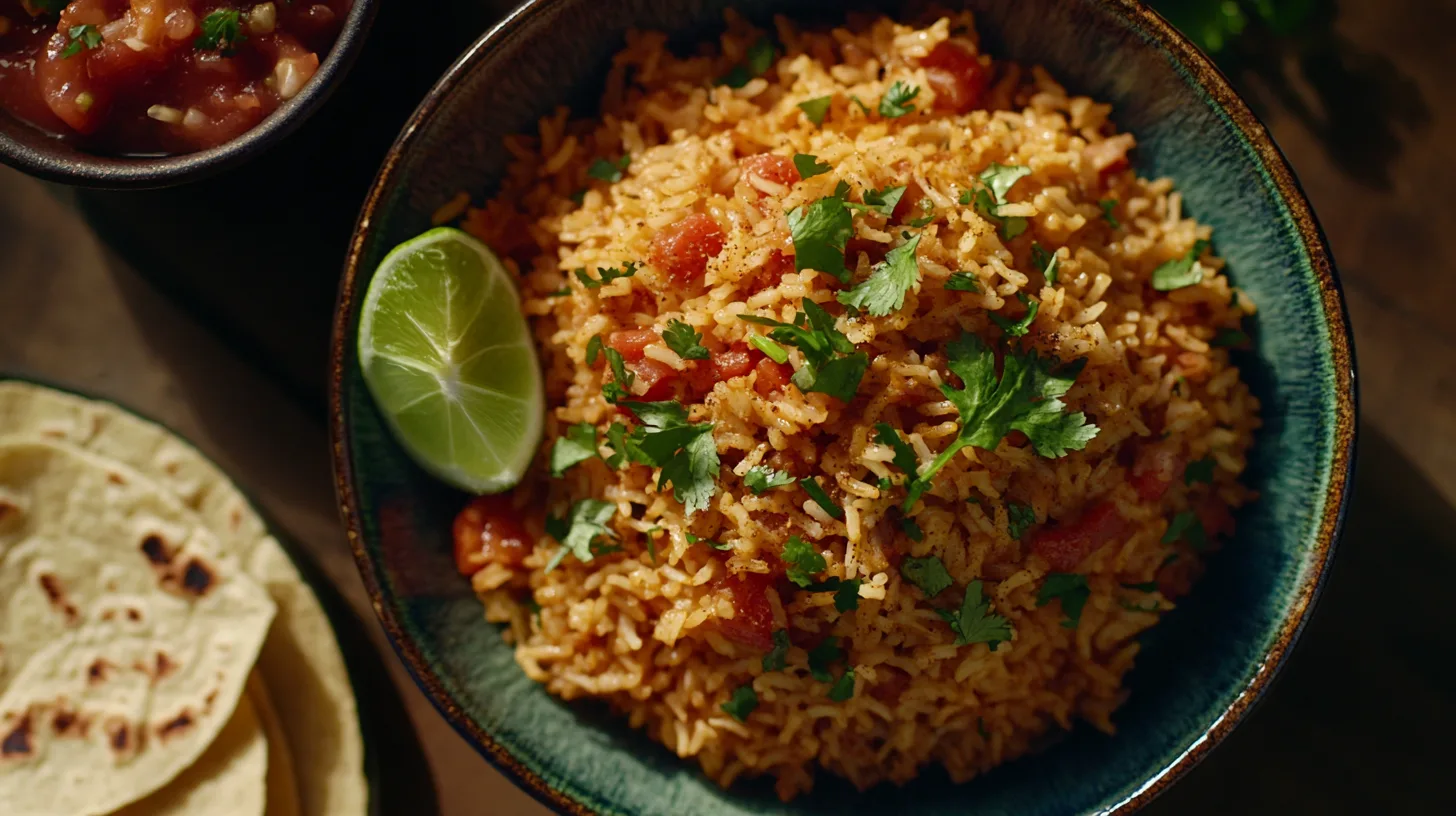Discover the Irresistible Spanish Rice Recipe That Everyone Will Love
Welcome to the delightful world of the Spanish Rice Recipe. This dish is not only a staple in many kitchens but also a versatile and flavorful addition to any meal. Whether you’re serving it as a side or incorporating it into a main course, this recipe promises to deliver mouthwatering results every time. Join me as we explore the rich history, variations, and secrets to making the perfect Spanish rice that will keep your family and friends coming back for more.
The Perfect Spanish Rice: A Flavorful and Easy Recipe
Introduction to Spanish Rice Recipe
Spanish rice recipe is a beloved dish that graces tables across cultures. While its name suggests a direct connection to Spain, the truth is that what we know today as Spanish rice has evolved through various culinary influences, particularly from Latin America. This dish is often characterized by its vibrant orange hue and rich flavor, which comes from cooking rice with tomatoes and spices.
The beauty of Spanish rice recipe lies in its adaptability; it can be served alongside tacos, enchiladas, or even as a standalone dish. Its appeal is universal, making it a popular choice for gatherings, potlucks, and family dinners. But what exactly distinguishes Spanish rice from other rice dishes? Let’s delve deeper.
What is Spanish Rice recipe? Origin and Variations
Understanding the essence of Spanish rice recipe requires a brief exploration of its origins. Though many assume it hails from Spain, the flavors and ingredients reflect a mixture of Spanish and Mexican culinary traditions. It typically includes long-grain rice sautéed with onions, garlic, bell peppers, and a variety of spices.
Variations abound, with some regions adding distinct elements like saffron or chorizo, while others incorporate different vegetables or beans. In essence, Spanish rice recipe is a canvas on which you can paint your culinary creativity. You may find it served in vibrant colors, infused with various spices or garnished with fresh herbs, showcasing the cook’s personal touch.
Why You’ll Love This Recipe: Simple, Flavorful, and Versatile
This Spanish Rice Recipe stands out for its simplicity and incredible flavor profile. With just a handful of ingredients and straightforward steps, you’ll create a dish that feels gourmet without the fuss. It’s perfect for busy weeknights, special occasions, or when you’re craving something comforting yet satisfying.
Moreover, the versatility of Spanish rice recipe allows it to complement many dishes. Pair it with grilled meats, use it as a filling for burritos, or serve it alongside a zesty salad. The possibilities are endless! The ease of customization means you can adjust the spice level, add proteins, or include seasonal vegetables according to your preference.
Key Ingredients for Authentic Spanish Rice recipe
To achieve authentic Spanish rice recipe, quality ingredients matter. The basic components typically include rice, tomatoes, broth, and a medley of spices. However, each ingredient plays a pivotal role in developing the overall flavor and texture of the dish.
From selecting the right type of rice to choosing fresh vegetables, understanding these ingredients ensures that your Spanish rice recipe turns out perfectly every time. Let’s uncover the essential components together.
Common Mistakes to Avoid When Making Spanish Rice recipe
While making Spanish rice recipe may seem straightforward, there are common pitfalls that can affect the final product. Overcooking the rice, using too much liquid, or neglecting to season adequately can lead to less-than-stellar results.
Awareness of these mistakes will empower you to create a dish that truly shines. Don’t worry; we’ll cover all the tips and tricks necessary to avoid these missteps so that you can master your Spanish rice recipe with confidence.

Gathering Your Ingredients: The Spanish Rice recipe Shopping List
Before we begin crafting our delicious dish, let’s take stock of what you’ll need to gather for your Spanish rice recipe. Having all the right ingredients on hand will streamline the process and ensure your cooking experience is as enjoyable as possible.
Rice Selection: Choosing the Best Rice for Spanish Rice recipe (Long Grain vs. Medium Grain)
Choosing the appropriate type of rice is crucial for achieving the desired texture in your Spanish rice recipe. Long grain rice, such as Basmati or Jasmine, tends to remain fluffy and separate after cooking. In contrast, medium grain rice, like Arborio or Calrose, can yield a creamier consistency due to its higher starch content.
For traditional Spanish rice recipe, long-grain rice is preferred. It absorbs flavors beautifully while retaining a pleasant bite. However, the choice ultimately boils down to your personal preference. Experimentation can yield delightful results, so don’t hesitate to try different varieties!
The Essential Vegetables: Onion, Garlic, and Bell Pepper
The foundation of flavor in your Spanish rice recipe comes largely from aromatic vegetables. Onions and garlic are must-haves, providing a robust base that enhances the overall taste of the dish.
Bell peppers add sweetness and a pop of color. Red, green, or yellow peppers can be used interchangeably, depending on your flavor preference. Sautéing these vegetables before adding rice helps build layers of flavor that will make your dish truly exceptional.
Tomato Base: Canned Tomatoes, Tomato Sauce, or Tomato Paste?
A tomato base is integral to achieving that characteristic flavor and vibrant color in Spanish rice recipe. You have several options here—canned diced tomatoes, tomato sauce, or even tomato paste. Each offers a different intensity of flavor, allowing you to customize the dish to your liking.
Canned diced tomatoes provide a fresh, chunky texture, whereas tomato sauce offers a smoother consistency. Tomato paste, though thicker, can deepen the flavor significantly. Consider experimenting with a combination of these options to find the balance that suits your palate best.
Broth is Key: Chicken Broth vs. Vegetable Broth for Maximum Flavor
The choice of broth can elevate your Spanish rice recipe to new heights. Chicken broth imparts a rich and savory depth, while vegetable broth offers a lighter, plant-based alternative.
Using homemade broth, if available, can significantly enhance the flavor profile; however, store-bought versions work well too. Just be mindful of sodium levels and opt for low-sodium varieties to maintain control over seasoning.
Spices and Seasoning: Achieving That Authentic Spanish Flavor Profile (Cumin, Chili Powder, Paprika)
Spices bring your Spanish rice recipe to life, giving it that authentic flair and depth of flavor. Cumin, chili powder, and paprika are essential in creating a well-rounded taste.
Cumin adds an earthy warmth, while chili powder brings subtle heat and complexity. Paprika, whether sweet or smoked, contributes vibrant color and a unique flavor. Adjust the quantity based on your personal preferences and experiment with additional spices like oregano or bay leaves for a customized twist.
Optional Additions: Jalapeños, Peas, Corn for Customized Flavor
Don’t hesitate to get creative with your Spanish rice recipe! Adding optional ingredients can elevate your dish from good to extraordinary. Jalapeños lend a spicy kick, while peas and corn can introduce sweetness and a burst of color.
Feel free to mix in cooked chicken, shrimp, or black beans for a heartier meal. The beauty of Spanish rice recipe is its adaptability, allowing you to tailor it to suit your guests’ tastes or your own cravings.

Step-by-Step Guide to Making Delicious Spanish Rice recipe
Now that we’ve gathered our ingredients, it’s time to dive into the step-by-step process to create mouth-watering Spanish rice recipe. Follow along closely, and soon you’ll be savoring the delightful aroma and tantalizing flavors.
Sautéing the Vegetables: Building the Flavor Base
Begin by heating a bit of oil in a large skillet or saucepan over medium heat. Once hot, add diced onions and garlic, allowing them to soften and become fragrant. This step is crucial, as the sautéing process develops the foundational flavors that will permeate the entire dish.
As the onions become translucent, toss in the diced bell peppers. Sauté until they are tender, which should take about five minutes. This medley of vegetables will create a flavorful base that infuses the rice with character and depth.
Toasting the Rice: The Secret to Fluffy, Non-Sticky Rice
Once you’ve sautéed the vegetables to perfection, it’s time to toast the rice. Add your rinsed and drained long-grain rice directly to the pan, stirring frequently for about three to four minutes. This step enhances the nutty flavor of the rice while preventing it from becoming mushy during cooking.
You want the rice to develop a slightly golden hue, which indicates that it’s been properly toasted. This technique is key to achieving that coveted fluffy texture rather than sticky clumps of rice.
Adding the Tomato Base and Broth: Achieving the Right Liquid Ratio
Next, it’s time to introduce your tomato base. Whether you’ve chosen canned tomatoes, tomato sauce, or paste, combine it with the toasted rice and sautéed vegetables. Stir everything together for a cohesive blend of flavors.
Now, add your broth to the mixture. The typical ratio is two cups of liquid for every cup of rice, but adjustments can be made, depending on the specific rice variety used. Make sure to stir well, ensuring that the rice is evenly distributed and submerged in the liquid.
Simmering to Perfection: The Importance of Low and Slow Cooking
Bring the mixture to a gentle boil, then reduce the heat to low, covering the pan with a lid. Allow the rice to simmer undisturbed for about twenty minutes. During this time, the rice will absorb the flavorful broth, transforming into a colorful and fragrant dish.
Avoid lifting the lid too frequently, as this releases steam and affects cooking. Trust the process, and resist the urge to peek!
Fluffing and Resting: The Final Touches for Perfectly Cooked Rice
After the cooking time has elapsed, remove the pan from heat but leave the lid on for another five to ten minutes. This resting period allows the rice to finish cooking and absorb any remaining moisture, resulting in perfectly fluffy grains.
Finally, use a fork to fluff the rice gently, separating the grains. This action enhances the texture, making it light and airy. Serve immediately or set aside for later, knowing that your Spanish rice recipe is now ready to shine!
Tips and Tricks for Spanish Rice recipe Success
Mastering the art of Spanish rice recipe requires attention to detail and a few key insights. Here are some helpful tips and tricks to ensure your dish turns out flawlessly each time you prepare it.
Achieving the Perfect Rice-to-Liquid Ratio: Golden Rules
Maintaining the right rice-to-liquid ratio is fundamental for perfect Spanish rice recipe. The general guideline is to use two parts liquid to one part rice. However, factors such as the type of rice and cooking method can influence this ratio.
Experimentation is encouraged! If you prefer softer rice, feel free to increase the liquid slightly. Keep track of your adjustments, so you can replicate your ideal results in future preparations.
Preventing Sticky Rice: Techniques and Troubleshooting
Sticky rice can ruin an otherwise delicious dish, but fear not! There are several techniques to prevent this from happening. First, rinse your rice thoroughly before cooking to eliminate excess surface starch.
Toasting the rice is another effective measure. If you find that your rice is still sticky after cooking, allow it to cool slightly before fluffing to break apart any clumps.
Boosting the Flavor: Using Homemade Broth or Roasted Vegetables
For an added boost of flavor, consider using homemade broth instead of store-bought options. Homemade broth is richer and more nuanced, elevating the taste of your Spanish rice significantly.
Roasting vegetables, such as tomatoes or bell peppers, before adding them to the rice can also intensify the flavor. Their caramelization brings out natural sweetness that complements the dish beautifully.
Controlling the Spice Level: Mild, Medium, or Spicy?
When it comes to spice, adjust according to preference! For those who enjoy milder flavors, opt for fewer jalapeños or a mild chili powder. Conversely, if you crave a bit of heat, increase the dosage gradually until you reach your desired level of spiciness.
Remember that flavors tend to develop while cooking, so start conservatively and taste test along the way to ensure it suits your palate.
Scaling the Recipe: Adjusting the Ingredients for Larger or Smaller Servings
Scaling your Spanish rice recipe up or down is simple. Just remember to maintain the proper rice-to-liquid ratios and adjust cooking times as needed.
For larger gatherings, double or triple the ingredients, but use multiple pots if necessary to prevent overcrowding. For smaller servings, simply halve the recipe while preserving the same steps and techniques.
Serving Suggestions and Pairing Ideas
Your Spanish rice is finally ready to be enjoyed! Now, let’s explore some enticing ways to serve and pair this delicious dish for a complete dining experience.
Spanish Rice as a Side Dish: Complementing Mexican and Spanish Cuisine
Spanish rice makes an excellent side dish for a plethora of cuisines, particularly Mexican and Spanish fare. Serve it alongside tacos, enchiladas, or quesadillas for a hearty meal packed with flavor.
Alternatively, pair it with grilled meats like chicken, steak, or fish to create a balanced plate. The rice adds a vibrant touch that complements the smoky flavors of grilled dishes beautifully.
Spanish Rice in Main Courses: Burrito Bowls, Stuffed Peppers, and More
Don’t hesitate to elevate your Spanish rice to a main course! Create burrito bowls by layering the rice with protein, beans, guacamole, and fresh salsa.
Stuffed peppers filled with Spanish rice, cheese, and ground meat make for a comforting and visually appealing meal. Get creative and incorporate your favorite ingredients to craft dishes that showcase the versatility of Spanish rice.
Topping Ideas: Cilantro, Lime Wedges, Avocado, and Sour Cream
Toppings can enhance the flavor and presentation of your Spanish rice dish. Fresh cilantro adds a bright and herbaceous note, while lime wedges offer a refreshing zing.
Creamy avocado slices and a dollop of sour cream make excellent accompaniments, balancing the dish’s flavors. Feel free to garnish with additional vegetables, cheese, or even nuts for crunch and texture.
Wine and Drink Pairings: Accompanying Your Spanish Rice Dish
Pairing wine with your Spanish rice can enhance the overall dining experience. A crisp white wine, such as Sauvignon Blanc or a light red like Pinot Noir, complements the dish beautifully.
For non-alcoholic options, consider pairing your Spanish rice with zesty fruit-infused waters or traditional beverages like horchata for a refreshing twist.

Storing and Reheating Spanish Rice
If you’re fortunate enough to have leftover Spanish rice, proper storage is essential for maintaining its flavor and texture. Here are some tips to keep your dish fresh for later enjoyment.
Proper Storage Techniques: Keeping Leftover Rice Fresh
Allow the rice to cool completely before storing it in an airtight container. This step prevents condensation, which can lead to sogginess. Store it in the refrigerator for up to four days or freeze it for longer shelf life.
For freezing, portion the rice into freezer-safe bags or containers, ensuring as much air as possible is removed. Label with the date to keep track of freshness.
Reheating Methods: Microwave, Stovetop, or Oven
Reheating Spanish rice can be done using several methods. The microwave is the quickest option—just sprinkle a bit of water over the rice and cover it to steam while reheating.
For stovetop reheating, place the rice in a saucepan with a splash of broth or water, stirring occasionally until heated through. Alternatively, you can reheat in the oven by spreading the rice in a baking dish, covering it with foil, and warming at a low temperature.
Freezing Spanish Rice: Extending its Shelf Life
Freezing Spanish rice is a great way to extend its shelf life without sacrificing quality. As previously mentioned, portion it into airtight containers or freezer bags, removing excess air to prevent freezer burn.
When you’re ready to enjoy it again, thaw it overnight in the refrigerator or use the microwave for quick defrosting. Reheat thoroughly before serving, and enjoy your flavorful creation once more!
Conclusion
In conclusion, mastering the Spanish Rice Recipe opens up a world of culinary adventure filled with flavor, versatility, and creativity. From exploring its rich history and variations to understanding key ingredients and preparation techniques, you now possess all the knowledge necessary to create this delectable dish.
Whether serving it as a side, incorporating it into main courses, or customizing it to suit your palate, Spanish rice is sure to impress your family and friends. Remember to embrace the joy of cooking, personalize your recipes, and don’t shy away from experimentation. With a little practice and love, you’ll be enjoying the perfect bowl of Spanish rice in no time!
Try these recipes next!
If you’re looking for new dishes to complement your chocolate chip muffins, here are some delicious options:

